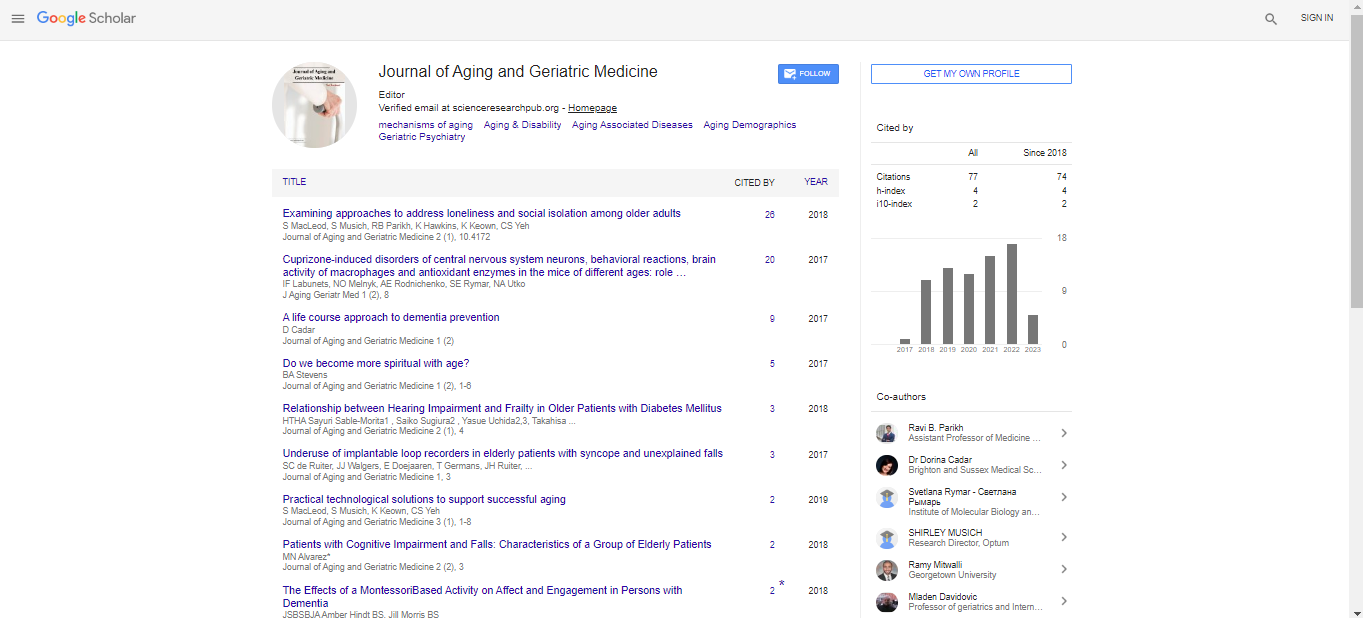Perspective, J Aging Geriatr Med Vol: 8 Issue: 1
Alzheimer's Disease: Major Illness in Older Adults
Magarit Perck*
Department of Human Genetics, University of Miami, Miami, USA
- *Corresponding Author:
- Magarit Perck
Department of Human Genetics,
University of Miami,
Miami,
USA
E-mail: magarit_perck@gmail.com
Received date: 04 November, 2023, Manuscript No. AGM-23-119214;
Editor assigned date: 07 November, 2023, PreQC No. AGM-23-119214 (PQ);
Reviewed date: 21 November, 2023, QC No. AGM-23-119214;
Revised date: 15 August, 2024, Manuscript No. AGM-23-119214 (R);
Published date: 22 August, 2024, DOI: 10.4172/2576-3946.1000182
Citation: Perck M (2024) Alzheimer's Disease: Major Illness in Older Adults. J Aging Geriatr Med 8:1.
Introduction
The main risk factor for late-onset Alzheimer's disease, which makes up more than 95% of cases of Alzheimer's Disease (AD), is getting older. It is uncertain what mechanism contributes to the agingrelated sensitivity to LOAD. It's thought that cellular senescence, a permanent condition of cell growth inhibition, plays a significant role in the aging process and aging-related illnesses like AD. Removing senescent cells using genetic or pharmacological means improves cognition in AD model mice and mitigates neuropathology’s produced by tau protein and β-amyloid (Aβ) peptide, indicating a critical role for cellular senescence in AD pathophysiology. Nevertheless, despite a growing body of data indicating the importance of cellular senescence in AD and aging, little is understood about the processes underlying cell senescence and the ways in which senescent cells affect the neuropath physiology of AD.
Description
A brain ailment that worsens over time is Alzheimer's disease. It is typified by alterations in the brain that result in protein accumulation. Alzheimer's disease results in the ultimate death of brain cells and shrinkage of the brain. The most prevalent cause of dementia, which is characterized by a progressive loss of memory, thinking, behaviour, and social skills, is Alzheimer's disease. The way a person functions is impacted by these changes. In the US, 6.5 million adults 65 years of age and older have Alzheimer's disease. Over 70% of them are 75 years of age or older. 60% to 70% of the approximately 55 million people with dementia globally are thought to have Alzheimer's disease.
Our brains age with our bodies, just like the rest of us. Most of us ultimately become aware of some cognitive slowness and sporadic difficulties recalling specific details. But severe memory loss, disorientation, and other significant alterations in mental processes might indicate a deteriorating brain. The area of the brain that controls learning is where Alzheimer's disease usually starts to alter. Alzheimer's disease causes symptoms to worsen as it spreads throughout the brain.
The loss of neurons and synapses in the cerebral cortex and some subcortical areas is a hallmark of Alzheimer's disease. Gross atrophy of the impacted areas follows from this loss, including degeneration in the temporal and parietal lobes as well as portions of the frontal cortex and cingulate gyrus. Brainstem nuclei, in particular the locus coeruleus in the pons, are also degenerating. Studies employing MRI and PET have shown that when Alzheimer's disease progressed from moderate cognitive impairment to Alzheimer's disease, some brain areas shortened in size when compared to identical scans from older, healthy participants.
When Alzheimer's patients' brains are examined under a microscope, Aβ plaques and neurofibrillary tangles, particularly in the hippocampus, are easily evident. Nonetheless, neurofibrillary tangles in the neocortex may not always accompany Alzheimer's disease. Plaques are thick, generally insoluble accumulations of cellular debris and beta-amyloid peptide that surround neurons. Neurofibrillary tangles, or tangles, are collections of the hyperphosphorylated tau protein, which is connected with microtubules and accumulates inside cells. While plaques and tangles are a natural part of aging for many older people, those who have Alzheimer's disease have more of them in some areas of the brain, such as the temporal lobe. Alzheimer's patients' brains do not always include lewy bodies.
Conclusion
It has been determined that tau protein accumulates in neurofibrillary tangles in the brain while amyloid beta protein accumulates in amyloid plaques, causing Alzheimer's disease, a proteopathy caused by aberrant protein folding. Amyloid Beta (Aβ) peptides, which are 39–43 amino acids long, are the building blocks of plaques. Amyloid beta is a subunit of the larger transmembrane protein known as Amyloid-beta Precursor Protein (APP), which may pass through the membrane of a neuron. Neuron survival, growth, and post-injury repair all depend on APP. The proteolytic action of beta and gamma secretases results in the fragmentation of APP into smaller pieces in Alzheimer's disease. One of these pieces results in amyloid beta fibrils, which clump together and deposit outside of neurons in dense formations known as amyloid plaques.
 Spanish
Spanish  Chinese
Chinese  Russian
Russian  German
German  French
French  Japanese
Japanese  Portuguese
Portuguese  Hindi
Hindi 